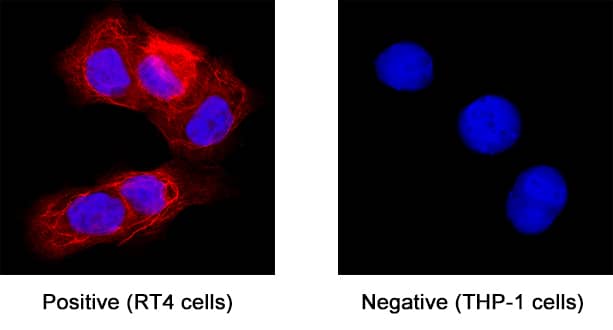CXCL17/VCC-1 Products
Dendritic cell and monocyte chemokine-like protein (DMC), also known as VEGF-correlated chemokine-1 (VCC-1) and CXCL17, is a novel secreted molecule that belongs to the intercrine alpha (or CXC) family of chemokines. It has no predicted N-glycosylation sites, so cleavage of a 22 amino acid (aa) signal sequence likely results in a mature human DMC of 97 aa and 11 kDa. CXCL17 is constitutively produced by bronchiolar, mammary, and intestinal epithelium, vascular endothelial cells, and multiple tumor types. It induces the chemotaxis of quiescent, but not LPS-activated, peripheral blood monocytes and dendritic cells, and also is noted to specifically bind to these cells. CXCL17 expression is increased in endothelial cells when they are induced to form tubes in vitro. Transgenic overexpression in NIH3T3 cells causes up-regulation of proteins such as VEGF and FGF basic, and increases cell growth rate and tumorigenicity. CXCL17 and two other chemokines that play roles in angiogenesis, CXCL1/GRO and CXCL8/IL-8, show significantly correlated expression with that of VEGF in primary lung, breast and esophageal tumors. CXCL17 is therefore suggested to play a role in tumor angiogenesis. Mature human CXCL17 shares 73%, 71% and 64% amino acid sequence identity with bovine, mouse and rat CXCL17, respectively.
44 results for "CXCL17/VCC-1" in Products
44 results for "CXCL17/VCC-1" in Products
CXCL17/VCC-1 Products
Dendritic cell and monocyte chemokine-like protein (DMC), also known as VEGF-correlated chemokine-1 (VCC-1) and CXCL17, is a novel secreted molecule that belongs to the intercrine alpha (or CXC) family of chemokines. It has no predicted N-glycosylation sites, so cleavage of a 22 amino acid (aa) signal sequence likely results in a mature human DMC of 97 aa and 11 kDa. CXCL17 is constitutively produced by bronchiolar, mammary, and intestinal epithelium, vascular endothelial cells, and multiple tumor types. It induces the chemotaxis of quiescent, but not LPS-activated, peripheral blood monocytes and dendritic cells, and also is noted to specifically bind to these cells. CXCL17 expression is increased in endothelial cells when they are induced to form tubes in vitro. Transgenic overexpression in NIH3T3 cells causes up-regulation of proteins such as VEGF and FGF basic, and increases cell growth rate and tumorigenicity. CXCL17 and two other chemokines that play roles in angiogenesis, CXCL1/GRO and CXCL8/IL-8, show significantly correlated expression with that of VEGF in primary lung, breast and esophageal tumors. CXCL17 is therefore suggested to play a role in tumor angiogenesis. Mature human CXCL17 shares 73%, 71% and 64% amino acid sequence identity with bovine, mouse and rat CXCL17, respectively.
| Source: | E. coli |
| Accession #: | NP_940879 |
| Applications: | BA |
| Reactivity: | Human |
| Details: | Mouse IgG2b Monoclonal Clone #422208 |
| Applications: | WB, CyTOF-ready, ICC, ICFlow |
| Reactivity: | Human |
| Details: | Mouse IgG1 Monoclonal Clone #422204 |
| Applications: | IHC, ICC |
| Reactivity: | Human |
| Details: | Sheep IgG Polyclonal |
| Applications: | WB |
| Reactivity: | Mouse |
| Details: | Sheep IgG Polyclonal |
| Applications: | WB |
| Reactivity: | Mouse |
| Details: | Rat IgG2b Monoclonal Clone #510614 |
| Applications: | WB |
| Source: | E. coli |
| Accession #: | Q5UW37.1 |
| Applications: | BA |
| Reactivity: | Mouse |
| Details: | Sheep IgG Polyclonal |
| Applications: | WB |
| Reactivity: | Human |
| Details: | Mouse IgG2b Monoclonal Clone #422208 |
| Applications: | ICFlow |
| Reactivity: | Human |
| Details: | Mouse IgG2b Monoclonal Clone #422208 |
| Applications: | ICFlow |
| Reactivity: | Human |
| Details: | Mouse IgG2b Monoclonal Clone #422208 |
| Applications: | ICFlow |
| Reactivity: | Human |
| Details: | Mouse IgG2b Monoclonal Clone #422208 |
| Applications: | ICFlow |
| Reactivity: | Human |
| Details: | Mouse IgG2b Monoclonal Clone #422208 |
| Applications: | ICFlow |
| Reactivity: | Human |
| Details: | Mouse IgG2b Monoclonal Clone #422208 |
| Applications: | ICFlow |
| Reactivity: | Human |
| Details: | Mouse IgG2b Monoclonal Clone #422208 |
| Applications: | ICFlow |
| Applications: | ELISA |
| Applications: | ELISA |
| Reactivity: | Human |
| Details: | Mouse IgG2B Monoclonal Clone #422208 |
| Applications: | WB, ICC/IF, Flow, CyTOF-ready |
| Reactivity: | Human |
| Details: | Mouse IgG2B Monoclonal Clone #422208 |
| Applications: | WB, ICC/IF, Flow, CyTOF-ready |
Contains 4 membranes - each spotted in duplicate with 31 different chemokine antibodies
| Applications: | Bioactivity, PAGE |
| Applications: | Bioactivity, PAGE |
| Reactivity: | Human |
| Details: | Mouse IgG2B Monoclonal Clone #422208 |
| Applications: | WB, ICC/IF, Flow, CyTOF-ready |
| Reactivity: | Human |
| Details: | Mouse IgG2B Monoclonal Clone #422208 |
| Applications: | WB, ICC/IF, Flow, CyTOF-ready |
| Reactivity: | Human |
| Details: | Mouse IgG2B Monoclonal Clone #422208 |
| Applications: | WB, ICC/IF, Flow, CyTOF-ready |






![ELISA: Human CXCL17/VCC-1 - Ready-To-Use ELISA Kit (Colorimetric) [NBP3-38839] Human CXCL17/VCC-1 - Ready-To-Use ELISA Kit (Colorimetric)](https://resources.bio-techne.com/images/products/nbp3-38839_human-cxcl17-vcc-1-ready-to-use-elisa-kit-colorimetric-211020241528245.png)
![ELISA: Human CXCL17/VCC-1 ELISA Kit (Colorimetric) [NBP3-38840] Human CXCL17/VCC-1 ELISA Kit (Colorimetric)](https://resources.bio-techne.com/images/products/nbp3-38840_human-cxcl17-vcc-1-elisa-kit-colorimetric-2110202415343943.png)


![SDS-PAGE: Recombinant Human CXCL17/VCC-1 Protein [NBP2-35133] SDS-PAGE: Recombinant Human CXCL17/VCC-1 Protein [NBP2-35133]](https://resources.bio-techne.com/images/products/Human-CXCL17-VCC-1-Protein-SDS-Page-NBP2-35133-img0001.jpg)